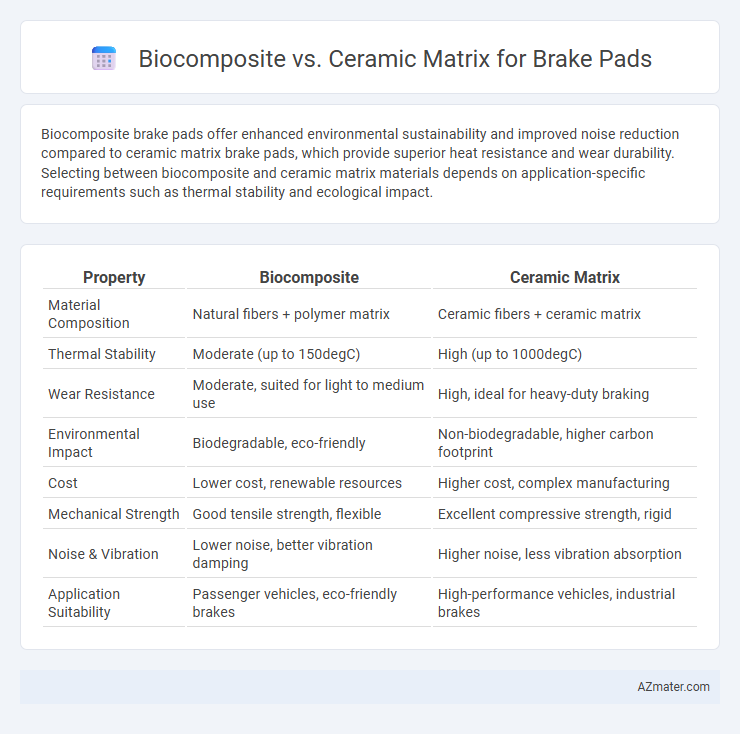Biocomposite brake pads offer enhanced environmental sustainability and improved noise reduction compared to ceramic matrix brake pads, which provide superior heat resistance and wear durability. Selecting between biocomposite and ceramic matrix materials depends on application-specific requirements such as thermal stability and ecological impact.
Table of Comparison
| Property | Biocomposite | Ceramic Matrix |
|---|---|---|
| Material Composition | Natural fibers + polymer matrix | Ceramic fibers + ceramic matrix |
| Thermal Stability | Moderate (up to 150degC) | High (up to 1000degC) |
| Wear Resistance | Moderate, suited for light to medium use | High, ideal for heavy-duty braking |
| Environmental Impact | Biodegradable, eco-friendly | Non-biodegradable, higher carbon footprint |
| Cost | Lower cost, renewable resources | Higher cost, complex manufacturing |
| Mechanical Strength | Good tensile strength, flexible | Excellent compressive strength, rigid |
| Noise & Vibration | Lower noise, better vibration damping | Higher noise, less vibration absorption |
| Application Suitability | Passenger vehicles, eco-friendly brakes | High-performance vehicles, industrial brakes |
Introduction to Brake Pad Materials
Brake pads commonly utilize biocomposite and ceramic matrix materials, each offering distinct advantages in friction performance and wear resistance. Biocomposites incorporate natural fibers and resins, providing eco-friendly alternatives with improved vibration damping and lower noise levels. Ceramic matrix brake pads deliver superior thermal stability and consistent friction, making them ideal for high-performance and heavy-duty braking applications.
Overview of Biocomposite Brake Pads
Biocomposite brake pads consist of natural fibers combined with resin matrices, offering a sustainable alternative to traditional materials. These pads provide enhanced environmental benefits, reduced wear on brake rotors, and lower noise levels compared to ceramic matrix counterparts. Their composition allows for improved energy absorption and temperature resistance, making them increasingly popular in eco-friendly automotive applications.
Ceramic Matrix Brake Pads: An Insight
Ceramic matrix brake pads offer superior heat resistance and reduced brake dust compared to biocomposite pads, enhancing vehicle performance and longevity. Their composition, typically including ceramic fibers and nonferrous materials, ensures consistent friction levels across temperatures, promoting safety and durability. These pads also exhibit quieter operation and minimal rotor wear, making them a preferred choice for high-performance and luxury vehicles.
Material Composition and Structure Comparison
Biocomposite brake pads incorporate natural fibers such as hemp, flax, or cellulose embedded in a resin matrix, offering eco-friendly alternatives with high wear resistance and lower environmental impact. Ceramic matrix brake pads consist primarily of ceramic fibers and fillers combined with bonding agents, providing superior thermal stability, consistent friction coefficient, and reduced brake dust. The composite structure of biocomposites enables lightweight performance and vibration damping, while the dense, inorganic ceramic matrix ensures enhanced hardness and heat dissipation in high-temperature braking conditions.
Performance Analysis: Friction and Wear
Biocomposite brake pads exhibit lower friction coefficients ranging between 0.35 and 0.45, enhancing consistent braking performance under varied conditions, while ceramic matrix pads maintain higher thermal stability with friction values around 0.38 to 0.43. Wear rates for biocomposite materials are generally higher, approximately 1.2 x 10-6 mm3/N*m, due to organic binder degradation, whereas ceramic matrix composites demonstrate superior wear resistance, with wear rates near 0.7 x 10-6 mm3/N*m. The enhanced thermal conductivity and structural integrity of ceramic matrices contribute to reduced fade and consistent friction during high-load braking scenarios.
Thermal Stability and Heat Dissipation
Biocomposite brake pads exhibit superior thermal stability due to their organic fibers and resin matrix, which absorb and distribute heat efficiently, reducing the risk of thermal degradation during prolonged braking. Ceramic matrix brake pads offer exceptional heat dissipation properties, leveraging inorganic compounds to withstand high temperatures without deformation or wear, ensuring consistent braking performance under extreme thermal conditions. The choice between biocomposite and ceramic matrix materials impacts thermal management, with biocomposites favoring moderate heat resistance and ceramics excelling in high-temperature durability and rapid heat dispersion.
Environmental Impact and Sustainability
Biocomposite brake pads, made from natural fibers and biodegradable resins, offer significantly lower environmental impact than ceramic matrix counterparts by reducing reliance on non-renewable materials and decreasing emissions during manufacturing. Ceramic matrix brake pads, while providing superior heat resistance and wear performance, involve energy-intensive production processes and generate non-biodegradable waste, contributing to long-term environmental challenges. The sustainability of biocomposite brake pads stems from their renewable sourcing, easier recycling potential, and reduced pollutant release during use, making them a more eco-friendly choice in automotive brake systems.
Cost Efficiency and Manufacturing Aspects
Biocomposite brake pads offer significant cost efficiency due to the use of renewable, low-cost natural fibers and simplified manufacturing processes compared to ceramic matrix pads, which involve expensive raw materials and energy-intensive sintering techniques. Manufacturing biocomposites generally requires lower temperatures and less specialized equipment, reducing production expenses and environmental impact. Ceramic matrix brake pads, while providing superior heat resistance and wear performance, entail higher fabrication complexity and costs, limiting their widespread cost-effective application.
Application Suitability: Biocomposite vs Ceramic Matrix
Biocomposite brake pads excel in automotive and light-duty applications due to their enhanced environmental sustainability, lower noise levels, and effective performance under moderate temperatures. Ceramic matrix brake pads are more suitable for high-performance and heavy-duty vehicles, offering superior heat resistance, reduced wear, and consistent friction under extreme braking conditions. Selection depends on balancing cost, operational temperature range, and desired durability tailored to specific vehicle and driving demands.
Future Trends in Brake Pad Technology
Future trends in brake pad technology highlight biocomposites for their lightweight, eco-friendly properties, offering reduced carbon emissions and enhanced wear resistance compared to traditional ceramic matrix composites. Innovations in material engineering aim to improve thermal stability and friction consistency while minimizing environmental impact through sustainable sources and recyclable components. Emerging research emphasizes hybrid composites combining biobased fibers with ceramic matrices to optimize performance in electric and autonomous vehicles.

Infographic: Biocomposite vs Ceramic Matrix for Brake Pad
 azmater.com
azmater.com